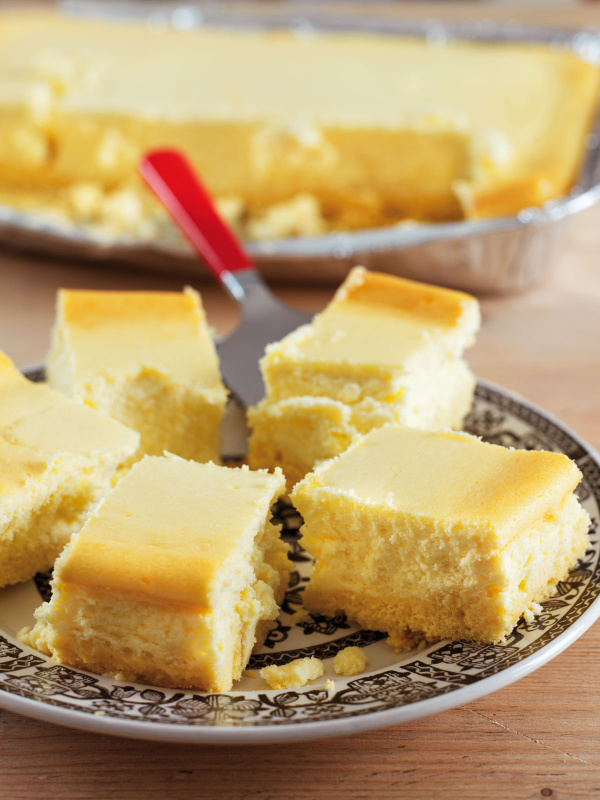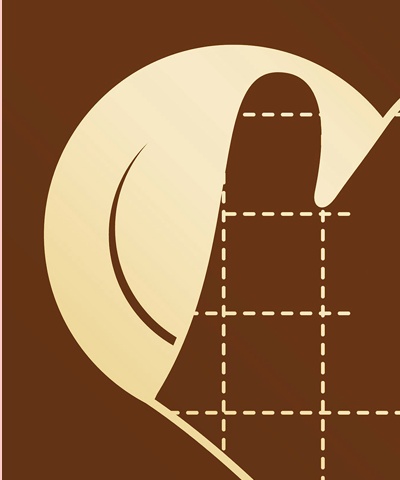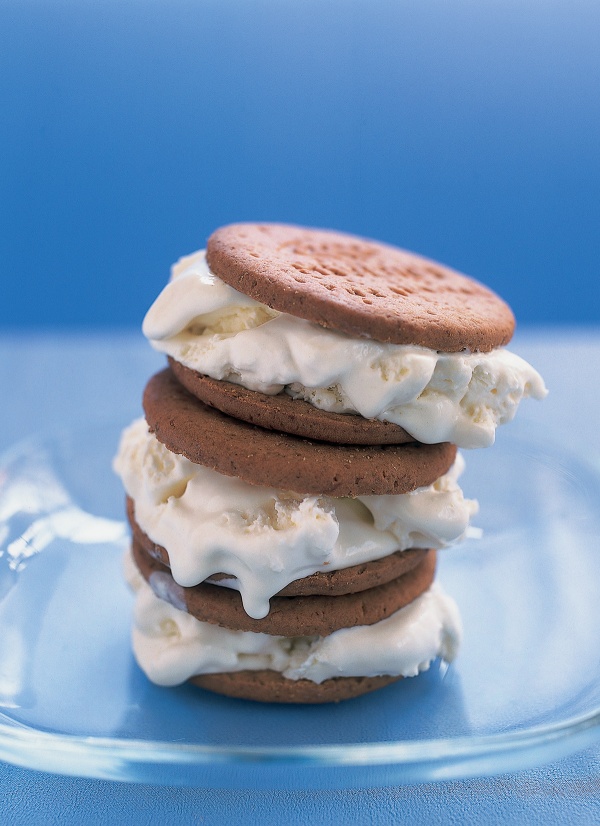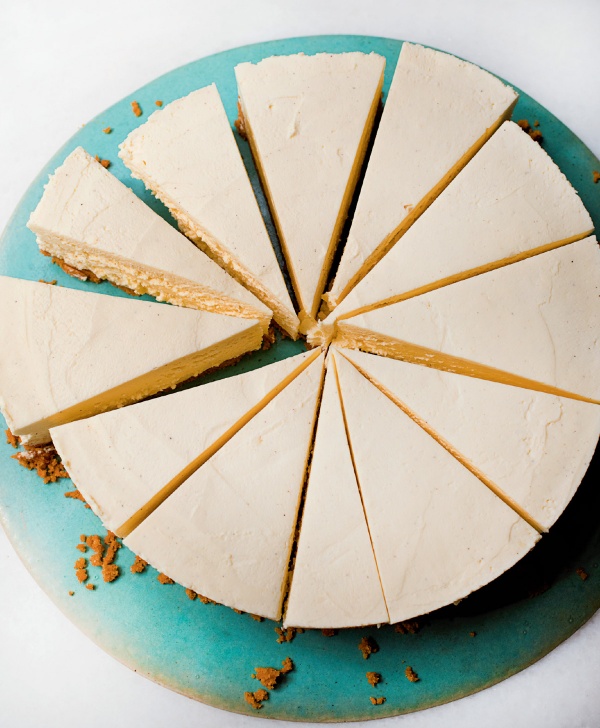Old-Fashioned Cheesecake
by Nigella. Featured in KITCHENIntroduction
I've made many a cheesecake, and as I go I seem to get further and further away from its — and my — Eastern European origins. But you know, the play is part of the pleasure. There's no less joy to be had, though, from returning to the start of it all, and this is really what cheesecake was — a great solid block of it — when it first came over here. You can still find this, occasionally, in delis, but it's rare. I love its denseness and lemoniness, and the way it reminds me of tea with my maternal grandmother, with her austere china and indulgent love.
For some reason, curd cheese is not always easy to find these days, but if you live near a Polish shop, or your supermarket has a Polish food section, do look for Twaróg.
As with all cheesecakes (with the exception of the Basque Burnt Cheesecake) this needs to be made at least the day before you want to eat it.
I've made many a cheesecake, and as I go I seem to get further and further away from its — and my — Eastern European origins. But you know, the play is part of the pleasure. There's no less joy to be had, though, from returning to the start of it all, and this is really what cheesecake was — a great solid block of it — when it first came over here. You can still find this, occasionally, in delis, but it's rare. I love its denseness and lemoniness, and the way it reminds me of tea with my maternal grandmother, with her austere china and indulgent love.
For some reason, curd cheese is not always easy to find these days, but if you live near a Polish shop, or your supermarket has a Polish food section, do look for Twaróg.
As with all cheesecakes (with the exception of the Basque Burnt Cheesecake) this needs to be made at least the day before you want to eat it.

Share or save this
Ingredients
Makes: 16 slabs
For the base
- 225 grams plain flour
- 1 teaspoon baking powder
- 50 grams caster sugar
- 25 grams soft unsalted butter
- 1 large egg
- 45 millilitres full fat milk
For the filling
- 725 grams curd cheese
- 150 grams caster sugar
- 4 large eggs (separated)
- 50 grams cornflour or potato flour
- 3 x 15ml tablespoons fresh lemon juice
- 1 teaspoon vanilla extract
- ½ teaspoon salt
- 250 millilitres double cream (softly whipped)
For the base
- 1½ cups all-purpose flour
- 1 teaspoon baking powder
- ¼ cup superfine sugar
- 2 tablespoons soft unsalted butter
- 1 large egg
- 3 tablespoons whole milk
For the filling
- 3 cups fresh farmer’s cheese or Neufchâtel
- 150 grams superfine sugar
- 4 large eggs (separated)
- ½ cup cornstarch or potato flour
- 3 tablespoons fresh lemon juice
- 1 teaspoon vanilla extract
- ½ teaspoon salt
- 1 cup heavy cream (softly whipped)
Method
You will need 2 x foil trays or 1 x foil-lined baking tin approx. 30 x 20 x 5cm / 13 x 9 x 2 inches.
- Preheat the oven to 170°C/150°C Fan/325°F, and if you're using the disposable foil trays, put one inside the other — to help with any wibbly-wobbling as you transfer your uncooked cheesecake to the oven later — and put a baking tray in the oven for them to sit on.
- For the base, put the flour and baking powder in the bowl of a food processor along with the 50g / ¼ cup caster sugar, 25g / 2 tablespoons soft butter and 1 egg. Process and then, with the motor running, add the milk and when the mixture begins to clump together, stop. Or, if doing this by hand, rub the butter into the flour in a bowl and then beat in the other ingredients with a wooden spoon.
- Tip the mixture out into a foil tray or foil-lined baking tin. Using your hands or the back of a spoon, press this in to make as even a layer as possible. Bake in the oven for 10 minutes. Let it cool a little before pouring in the cheese mixture.
- Put the curd cheese in a bowl and beat in the sugar followed by the egg yolks. Beat in the cornflour (or potato flour, which is the more old-fashioned and authentic choice, but there's nothing in it really, tastewise) followed by the lemon juice, vanilla extract and salt, and then fold in the softly whipped cream.
- In another bowl, beat the egg whites until soft peaks form and then add a ladleful to the cheese mixture and stir in vigorously. Fold the rest of the whites in more gently in 3-4 batches.
- Pour and scrape the filling into the dough-lined foil tray or tin, then carefully transfer to the oven and leave to bake for 1 hour, by which time it will be set on top and, although it won't feel cooked completely underneath, the surface should be slightly scorched in places. I love that.
- Remove to a wire rack to cool, still in its tin, and be prepared for the fact that it will probably crack a bit as it cools. Regard this as the stamp of authenticity. Chill the cheesecake, covered, overnight in the fridge, before serving.
You will need 2 x foil trays or 1 x foil-lined baking tin approx. 30 x 20 x 5cm / 13 x 9 x 2 inches.
- Preheat the oven to 170°C/150°C Fan/325°F, and if you're using the disposable foil trays, put one inside the other — to help with any wibbly-wobbling as you transfer your uncooked cheesecake to the oven later — and put a baking tray in the oven for them to sit on.
- For the base, put the flour and baking powder in the bowl of a food processor along with the 50g / ¼ cup superfine sugar, 25g / 2 tablespoons soft butter and 1 egg. Process and then, with the motor running, add the milk and when the mixture begins to clump together, stop. Or, if doing this by hand, rub the butter into the flour in a bowl and then beat in the other ingredients with a wooden spoon.
- Tip the mixture out into a foil tray or foil-lined baking tin. Using your hands or the back of a spoon, press this in to make as even a layer as possible. Bake in the oven for 10 minutes. Let it cool a little before pouring in the cheese mixture.
- Put the fresh farmer’s cheese or Neufchâtel in a bowl and beat in the sugar followed by the egg yolks. Beat in the cornstarch (or potato flour, which is the more old-fashioned and authentic choice, but there's nothing in it really, tastewise) followed by the lemon juice, vanilla extract and salt, and then fold in the softly whipped cream.
- In another bowl, beat the egg whites until soft peaks form and then add a ladleful to the cheese mixture and stir in vigorously. Fold the rest of the whites in more gently in 3-4 batches.
- Pour and scrape the filling into the dough-lined foil tray or tin, then carefully transfer to the oven and leave to bake for 1 hour, by which time it will be set on top and, although it won't feel cooked completely underneath, the surface should be slightly scorched in places. I love that.
- Remove to a wire rack to cool, still in its tin, and be prepared for the fact that it will probably crack a bit as it cools. Regard this as the stamp of authenticity. Chill the cheesecake, covered, overnight in the fridge, before serving.
Additional Information
MAKE AHEAD:
Make the cheesecake up to 2 days ahead and cool and chill as directed. Do not cover until completely cold, then cover with clingfilm, making sure that the covering does not touch the surface. The cheesecake will keep in the fridge for up to 4 days total.
FREEZE:
The cheesecake can be frozen for up to 1 month. Make sure it is thoroughly chilled then wrap it, still in its tin, in a double layer of clingfilm and 1 layer of foil, ensuring that the wrapping doesn't touch the top surface. Defrost overnight in the fridge and eat within 2 days.
MAKE AHEAD:
Make the cheesecake up to 2 days ahead and cool and chill as directed. Do not cover until completely cold, then cover with clingfilm, making sure that the covering does not touch the surface. The cheesecake will keep in the fridge for up to 4 days total.
FREEZE:
The cheesecake can be frozen for up to 1 month. Make sure it is thoroughly chilled then wrap it, still in its tin, in a double layer of clingfilm and 1 layer of foil, ensuring that the wrapping doesn't touch the top surface. Defrost overnight in the fridge and eat within 2 days.






Tell us what you think
Thank you {% member.data['first-name'] %}.
Explore more recipesYour comment has been submitted.
What 1 Other has said
-
Posted by RipuBains on 11th August 2021
Show more commentsI was always convinced that I didn’t like cheesecake and then, I came across Nigella’s many recipes. I’m a convert and, slightly worryingly for my waistline, a huge cheesecake fan! Thank you for leading me into this newfound love, Nigella!